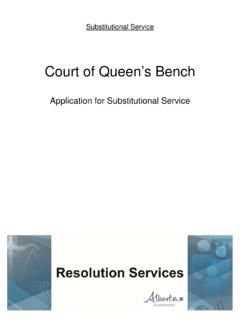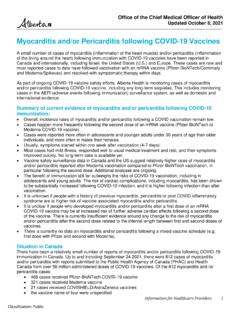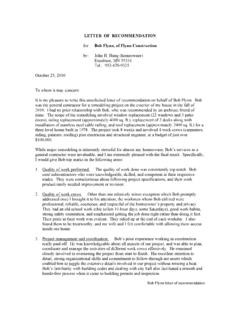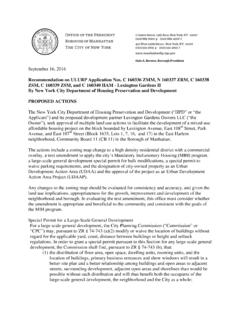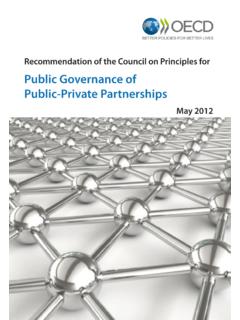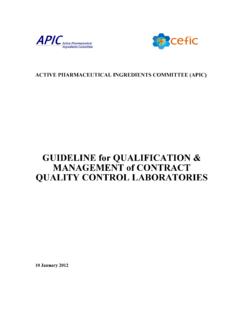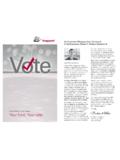Transcription of Alberta’s Wholesale Electricity Market Transition ...
1 Alberta s Wholesale Electricity Market Transition Recommendation OCTOBER 3, 2016 Alberta s Wholesale Electricity Market Transition RecommendationTable of EXECUTIVE SUMMARY INTRODUCTION Background The relationship between generation investment and reliability The shift to cleaner Electricity systems How renewables interact with the Market and grid The AESO s role in implementing the Climate Leadership Plan Ensuring a reliable Transition away from coal-fired Electricity Developing the Renewable Electricity Program Understanding the new demands on Alberta s Electricity system About this report ENERGY-ONLY Market SUSTAINABILITY ANALYSIS Quantitative assessment Description of AESO modelling Findings from quantitative Market analysis Qualitative Market analysis Themes Summary of quantitative and qualitative Market analysis Evaluating modifications to the current energy-only Market Conclusion: a Market change is needed ASSESSMENT OF DIFFERENT STRUCTURES General considerations Range of Electricity industry structures Government of Alberta s desired outcomes Detailed assessment results key policy outcomes Energy-only Market structure (EOM) Capacity Market structure (CAP) Long-term contract structure (LTC) Cost of service regulation structure (COS) 30 Alberta s Wholesale Electricity Market Transition Desired outcome of orderly Transition costs and risks Summary of desired outcomes assessment Stakeholder requirements and impact assessments Load requirements and impact assessment Generator requirements and impact assessment Coordination with CLP Electricity objectives Renewable Electricity Program Coal emissions phase-out Energy efficiency Implications for transmission policy RECOMMENDATION NEXT STEPS SUMMARY 43 Appendix A.
2 Financial and economic analysis 45 Appendix B: Cost analysis 88 Appendix C: Stakeholder impact 92 Appendix D: Capacity Market design considerations Executive summaryAlberta s Wholesale Electricity Market Transition Executive summaryThis report provides a summary of the AESO s analysis, followed by our recommendation that Alberta s Electricity Market structure needs to evolve from the current energy-only Market (EOM) to include a capacity Market . BACKGROUNDA lberta s Wholesale Electricity Market structure was designed to deliver safe, reliable, competitively priced Electricity . Since Alberta s Transition from a regulated Market , the current EOM structure has successfully achieved several outcomes: Met growing demand in one of North America s fastest growing jurisdictions Maintained reliability through an adequate supply of Electricity Incented generation development and investment in a wide range of technologies without incurring public debt Provided reasonable Electricity prices through a fair, efficient and openly competitive Market The EOM has delivered on the original objectives set for it.
3 More recently, however, an additional objective has emerged for the Electricity sector. Achieving a lower-carbon, sustainable Electricity system is now policy. Specific measures to achieve this objective were included in the Climate Leadership Plan (CLP), announced in November 2015. The CLP contained policy measures which will have a substantial impact on Alberta s mix of generation supply by 2030, as emissions from coal units are eliminated and significant amounts of new renewable generation are added. This changing supply mix has the potential to materially impact Electricity Market dynamics, and in turn, the ability of the current EOM to continue to deliver on the objectives of reliability and reasonable cost in the long run. To examine this, the AESO has conducted an assessment of the long-term sustainability of the current EOM in a future with a supply mix characterized by a Transition off coal and the integration of more renewable and natural gas generation. It should be noted that jurisdictions around the world (with a range of Electricity structures) have been grappling with the potential impact that increased amounts of renewable generation may have and the adjustments that may be required.
4 In this regard, Alberta is far from AESO has completed its assessment of the Wholesale Electricity Market and developed a recommendation for ensuring reliability as Alberta transitions to a lower-emission Electricity system. Executive summaryAlberta s Wholesale Electricity Market Transition RecommendationSummary of the AESO s analysis of the current energy-only Market going forwardThe AESO s analysis indicates that there is considerable uncertainty about whether sufficient investment in non-renewable generation, needed to ensure a reliable supply of Electricity , will occur in the future. The AESO modelled future economic and financial conditions and determined that adding high volumes of intermittent renewable generation to Alberta s Market through the Renewable Electricity Program will decrease the revenue available for all generators. As a result, revenue sufficiency ( the amount of revenue needed to recoup an investment and earn a profit) for investors and developers will decrease and investment may be deterred.
5 The AESO commissioned interviews with generation developers, investors and lenders and consulted with expert financial advisors. This effort indicated that interest in investing in energy-only markets has declined across North America, and that the Alberta Wholesale Electricity Market is not attractive to investors. There is far less capital available for investments in merchant power plants which have significant revenue uncertainty. Capital that is available is at much higher cost. A certain amount of revenue certainty is required to attract sufficient investor interest to deliver the generation build that Alberta will require going forward. The AESO also tested whether raising the price cap from $1,000/MWh to $5,000/MWh would attract sufficient investment to maintain reliability. We concluded that doing so may provide revenue sufficiency, but not revenue certainty and that the volatility that would result from this measure would create unacceptable risk for consumers.
6 While this measure could provide increased revenue, the AESO determined that it was unlikely to be successful in attracting investment due to increased price investment in new firm generation (or equivalent but alternative sources of firm supply such as demand response, etc.) to replace retiring coal-fired Electricity , the Market will be unable to support increasing volumes of intermittent renewables and provide a healthy reserve margin to manage through a wide range of system conditions. System reliability will be current EOM structure will not ensure the investment in new generation that Alberta will need in the future. Therefore, the AESO has concluded that Alberta must adopt a different Electricity structure to meet its objectives for the Electricity system. Alternatives to the current energy-only Market considered The AESO considered the suitability of four Electricity structures for meeting the government s desired policy outcomes for Alberta s Electricity Market -based structuresTwo non- Market structures Energy-only Market (EOM) Capacity Market (CAP) Long-term contract (LTC) Cost of service regulation (COS) Revenue sufficiency: Revenue earned is sufficient to: cover all operating costs, provide a return of capital invested, and provide a reasonable rate of return on capital invested.
7 Revenue certainty: The amount of revenue that will be earned is highly predictable or known ahead of time. Revenue stability: The amount of revenue earned does not vary significantly from one time period to the next. Executive summaryAlberta s Wholesale Electricity Market Transition RecommendationAn assessment of how well each structure is likely to achieve certain policy outcomes is provided below, and described in further detail in this 1: Alignment to desired outcomesPolicy outcomesElectricity structureEnergy-only Market (EOM)Capacity Market (CAP)Long-term contract (LTC)Cost of service regulation (COS)Reliable and resilient system Improved environmental performance Reasonable cost to Electricity customers Economic development and job creation Generally negative Generally positive Generally neutralTABLE 2: Orderly Transition - costs and risksPolicy outcomesElectricity structureEnergy-only Market (EOM)*Capacity Market (CAP)Long-term contract (LTC)Cost of service regulation (COS)Orderly Transition costs Orderly Transition risks High Low Medium* EOM represents costs and risks of introducing enhancementsTransitioning to a long-term contract or a cost of service regulation structure would represent fundamental change to the Electricity sector with commensurate risks and uncertainties.
8 Transition to either of these structures carries a significant risk of being a time-consuming and contentious process which could extend for several years. Treatment of legacy assets would need to be determined while the details of the new structure were developed and implemented. In addition, both of these structures would likely result in higher long-term costs to consumers as competitive forces are minimized and they are exposed to the risk of poor long-term decisions. By comparison, transitioning to a capacity Market could be accomplished in a more timely manner with significantly less disruption, and legacy issues would be minimized. A capacity Market would achieve key policy outcomes for the Electricity system. It would ensure continued reliability of the system in a cost-effective manner while enabling the Transition to a cleaner, lower-carbon Electricity system over the coming Executive summaryAlberta s Wholesale Electricity Market Transition RecommendationCONCLUSION The AESO has concluded that Alberta would be best served by the adoption of a capacity Market .
9 A capacity Market would provide the following combination of benefits which no other single Electricity structure can: Ensure reliability and specifically compensate for firm generation Provide suppliers with revenue sufficiency and stability Implement key areas of the CLP and be robust to accommodate potential future policy evolution Maintain Market incentives to preserve efficiency and flexibility Compatible with the existing transmission policy or future changes Allow a manageable amount of change with a high probability of success While raising the price cap in the existing energy-only Market structure can be introduced relatively quickly, there remains a high degree of risk that this measure would not ensure supply adequacy in the long run. There would be no time to course-correct if changes did not work. Although it is a more significant change, the introduction of a capacity Market would materially reduce supply adequacy risks. Lessons learned from other capacity markets can be employed to ease Alberta s Transition .
10 Implementation of a long-term contract or cost of service structure would involve significant change for the current industry. There is a high risk that the process to Transition to one of these structures would take longer, be more costly and contentious, and ultimately may jeopardize reliability and make achieving of CLP objectives unlikely. RECOMMENDATION The Government of Alberta should adopt a capacity Market structure The AESO recommends that Alberta move to adopt a capacity Market structure. Should the government accept our recommendation, the AESO requests ministerial direction as soon as possible to begin the design of a capacity Market for Alberta, including engagement of industry stakeholders. Earning their support through robust engagement will be critical to the success of this endeavour. Because of the complexity, we must emphasize the time that will be required to successfully implement this recommendation. The AESO estimates that design of the Market will take two years to complete, with an additional year to finalize legal contracts and set up the procurement process.


